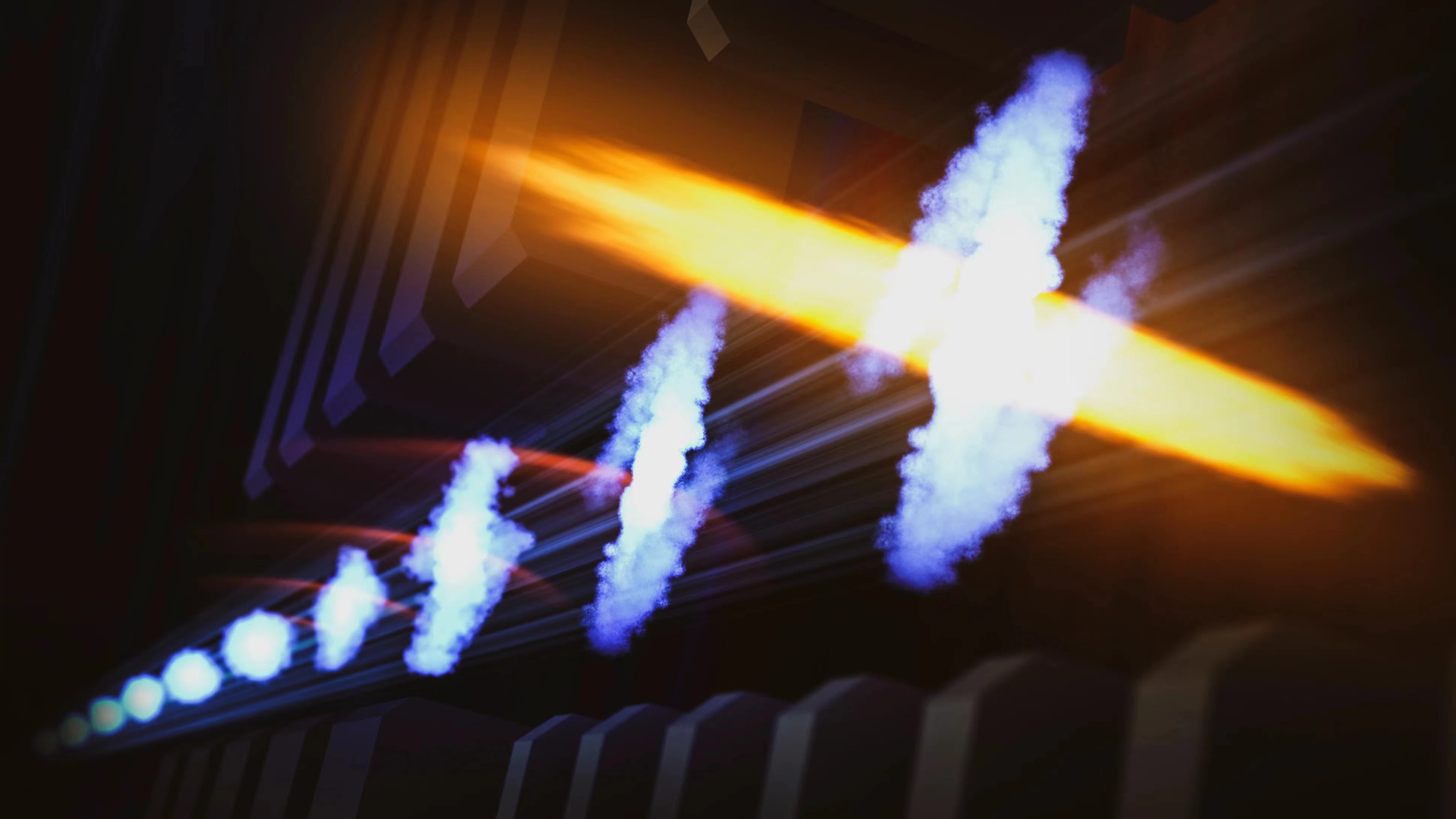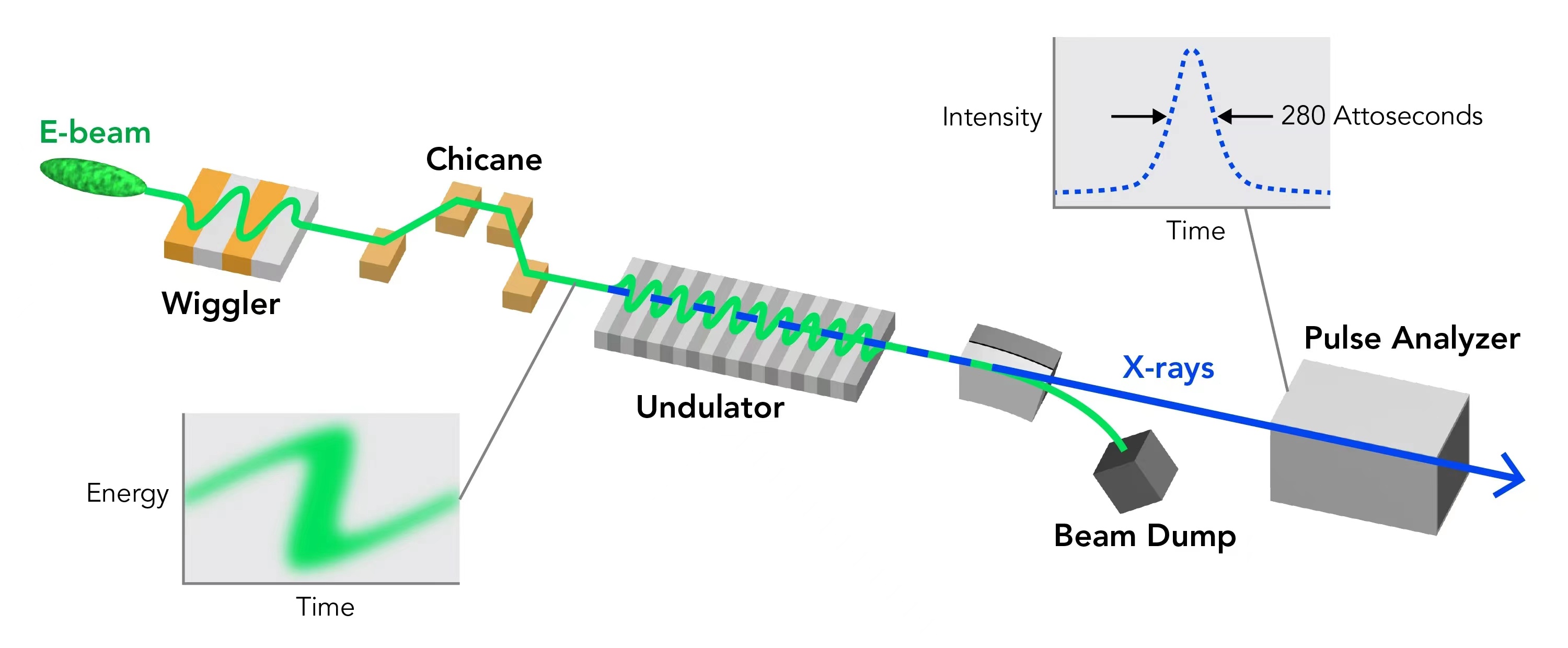创新背景
研究人员可以精确地观察到原子核的运动,但实际上驱动化学反应的更快的电子运动却被模糊了。
创新过程
在工作人员开始对SLAC的直线相干光源(LCLS) x射线激光器进行重大升级之前进行的实验中,XLEAP团队证明,他们可以产生精确计时的阿秒x射线脉冲对,可以让电子运动,然后记录这些运动。这些快照可以串联成定格动作电影。
像LCLS这样的x射线激光器通常会产生持续百万分之一秒或飞秒的闪光。这个过程从产生一束电子开始,它们被捆绑成短束,通过线性粒子加速器发送,在那里它们获得能量。它们以接近光速的速度行进,穿过一个被称为波动器的磁铁,在那里它们的一些能量被转换成x射线爆发。

电子束越短越亮,它们产生的x射线暴就越短,因此,制造阿秒x射线脉冲的一种方法是将电子压缩成越来越小、峰值亮度更高的电子束。XLEAP是实现这一点的一种聪明方法。
在LCLS,研究小组在波动器前插入了两组磁铁,使他们能够将每个电子束塑造成所需的形状:一个包含具有广泛能量范围的电子的强而窄的尖峰。
当通过波动器发送这些脉冲长度约为飞秒的脉冲时,它们产生的x射线脉冲要比这短得多。为了测量这些短得令人难以置信的x射线脉冲,科学家们设计了一种特殊的设备,x射线通过气体,剥离其中的一些电子,形成电子云。来自红外激光的圆偏振光与云相互作用,给电子一个踢。由于光的特殊偏振性,一些电子最终会比其他电子移动得更快。

这项技术与LCLS实施的另一个想法相似,它将时间映射到角度上,就像时钟的臂,它使研究人员能够测量电子速度和方向的分布,并据此计算x射线脉冲长度。
接下来,XLEAP团队将进一步优化他们的方法,这可能会产生更强、更短的脉冲。他们还在为LCLS- ii做准备,这是LCLS的升级版,它将每秒发射多达100万个x射线脉冲,比以前快8000倍。这将使研究人员能够进行他们长期以来梦寐以求的实验,比如研究单个分子及其在自然界最快时间尺度上的行为。
创新价值
通过XLEAP,研究人员可以创造出能量刚好的x射线脉冲,比以前类似能量的阿秒脉冲要亮100多万倍。它将使很多人们一直想用x射线激光器做的事情在阿秒的时间度量上实现。
创新关键点
XLEAP的阿秒x射线脉冲具有前所未有的强度和灵活性,是一个突破性的工具,可以观察和控制复杂系统中单个原子位置的电子运动。
Using a new method called XLEAP, electrons in chemical processes can be seen clearly
In experiments conducted before crews began a major upgrade of SLAC's Linear Coherent Light Source (LCLS) X-ray laser, the XLEAP team demonstrated that they could generate precisely timed attosecond X-ray pulse pairs that could move electrons and then record those movements. These snapshots can be strung together into stop-motion action movies.
X-ray lasers like LCLS typically produce flashes that last a millionth of a second, or femtosecond. The process starts with the generation of a beam of electrons, which are bundled into short beams and sent through linear particle accelerators, where they gain energy. Traveling at close to the speed of light, they pass through a magnet called a undulator, where some of their energy is converted into X-ray bursts.
The shorter and brighter the electron beams, the shorter the X-ray bursts they produce, so one way to create attosecond X-ray pulses is to compress the electrons into smaller and smaller beams with higher peak brightness. XLEAP is a clever way to do this.
At LCLS, the team inserted two sets of magnets in front of the undulator, allowing them to shape each electron beam into the desired shape: a strong, narrow spike containing electrons with a wide range of energies.
When these pulses, about a femtosecond in length, were sent through the undulator, they produced X-ray pulses much shorter than that. To measure these incredibly short X-ray pulses, scientists designed a special device in which the X-rays pass through the gas, stripping away some of its electrons to form an electron cloud. Circularly polarized light from the infrared laser interacts with the cloud, giving the electrons a kick. Because of light's special polarization, some electrons end up moving faster than others.
This technique, which is similar to another idea implemented by LCLS, maps time to angles, like the arms of a clock, and it enables researchers to measure the distribution of electron velocities and orientations, from which X-ray pulse lengths can be calculated.
Next, the XLEAP team will further refine their approach, which may result in stronger, shorter pulses. They are also preparing for LCLS-II, an upgraded version of LCLS that will emit up to a million X-ray pulses per second, 8,000 times faster than before. This will allow researchers to conduct experiments they have long dreamed of, such as studying individual molecules and how they behave on nature's fastest timescales.
智能推荐
大型强子对撞机升级有助于粒子物理学发展
2022-06-29借助大型强子对撞机升级更新氧离子、氢—氦对撞等物理实验。
涉及学科涉及领域研究方向将微小金刚石晶体创新应用于引力波探测器
2022-08-04伦敦大学学院领导的一项新研究表明,微小的钻石晶体可以用作一种非常灵敏的小型引力波探测器,能够测量引力波。
涉及学科涉及领域研究方向AI+粒子物理学 | 使用机器学习方法创新开发“粒子流算法”
2022-11-22研究证明了人工智能在粒子物理研究领域的可用性。
涉及学科涉及领域研究方向通过孤子微梳探索光学频率梳的量子特性
2022-07-27利用孤子微型频率梳研究频率梳的量子特性,探索光学频率梳量子特性和量子纠缠的存在。
涉及学科涉及领域研究方向